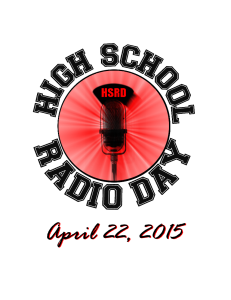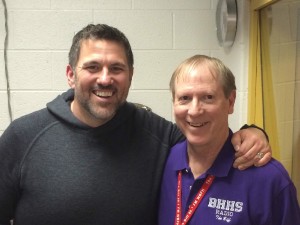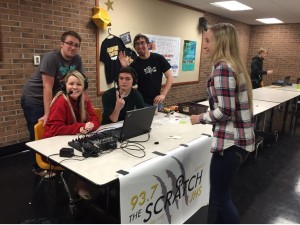Many in radio wonder where the next generation of talent is going to come from. As smaller markets increasingly lean on syndicated programming and other efficiencies, how can radio tap into the largest, emerging generation? Of course, we know them as Millennials.
Some also believe that many young people aren’t interested in radio, and have ventured out into digital media, tech startups, and other fields. And yet, if radio is to survive and prosper, having initiatives and strategies in place that reach out to this generation would seem to be an imperative.
 In this week’s edition of Radio’s Most Innovative, we’d like to introduce you to Pete Bowers, one of many people you’ve probably never heard of that is quietly having a very special impact on our industry. Bowers has been teaching radio broadcasting and electronic media in the Bloomfield Hills, Michigan school district for 39 years and during that time he has also been Station Manager of the district’s student radio station, WBFH-FM, which went on the air in 1976.
In this week’s edition of Radio’s Most Innovative, we’d like to introduce you to Pete Bowers, one of many people you’ve probably never heard of that is quietly having a very special impact on our industry. Bowers has been teaching radio broadcasting and electronic media in the Bloomfield Hills, Michigan school district for 39 years and during that time he has also been Station Manager of the district’s student radio station, WBFH-FM, which went on the air in 1976.
Since its debut, the station has won numerous awards including Station of the Year in Michigan nine times in the last 13 years and first place honors on five occasions in the national John Drury High School Radio Awards (where Bowers has also been recognized as Best Radio Station Advisor). He was President of the Michigan Association of Educational Broadcasters from 1984-1992 and was reelected to the position in 2010.
You’ve probably heard of College Radio Day, but Bowers saw the need and the opportunity to celebrate what’s happening in radio at the high school level. And so in 2011, he launched High School Radio Day (HSRD), an annual event that celebrates the efforts of young broadcasters from across the country.
The fourth HSRD took place this past Wednesday with 70 stations from 29 states participating. Now that it’s over, we asked Pete to share some thoughts on what led him to spearhead the concept, it mission, and how commercial broadcasters can help further cultivate interest from students who are involved in high school broadcast programs.
JM: What inspired you to start High School Radio Day?
PB: I was attending a radio convention in 2011 and went to a session about College Radio Day (CRD) with founder Rob Quicke. Being a high school radio station manager, I had a light bulb go off while sitting there. What if there was a “day” for just high school radio stations? Even though high school stations can register for CRD, it’s still called College Radio Day. I was worried that Rob might not want me to “borrow” his idea so I asked him if it would be OK to create a high school radio “day” and he gave me the thumbs up with the idea that both could exist and cross-promote each other. Since I had been involved in high school radio for 35 years at that point, I thought who might be better to get a HSRD founded than me?

JM: What was the most challenging aspect of getting the first year off the ground?
PB: The toughest part was getting stations to register for it initially. In March of 2012, I launched the HSRD website and decided on a date in May for our “day.” I made it easy for station advisors to register for the event on the website, but I knew three months wasn’t a lot of time. I decided to do it this way figuring we would just take baby steps the first year. We started with 31 stations from 16 states. This year we are up to 70 stations from 29 states.
JM: What are the goals of having a day to celebrate high school radio stations?
PB: To let people see what we do, how we do it and, in turn, get them to listen. It’s a chance for participating schools to put a spotlight on their station for the day. We send out press releases to local media and some stations get featured in local newspapers or on TV. During the actual day, stations do remote broadcasts from locations in their school to get the attention of students and faculty. At our school, we gave candy to students who downloaded our station app and had drawings for free Dairy Queen cones during lunch. Did we get new listeners? I hope so.
JM: What messages are you trying to communicate to listeners or people in communities that have high school broadcast programs?
PB: There are so many options for listeners nowadays, so we want to be sure their local high school station is one of them. We want people in our communities to give high school radio a listen and they might just like what they hear. The slogan for my station is “Hit Music, Hot Topics, Sports Talk.” When we play music, we play the hits. When we talk hot topics, it’s interesting and we hope entertaining. I think high school broadcasters have a lot to offer listeners – things they won’t hear on college or commercial stations.
JM: What message are you sending to broadcasters with High School Radio Day?
PB: Even though there are less than 200 high school radio stations in the U.S., we are training the rising stars of broadcasting who will take over the industry. Major league

baseball has its minor league teams producing the next MLB player. High school and college broadcasters are the Toledo Mud Hens of the Detroit Tiger organization.
JM: What role would you suggest commercial broadcasters play when it comes to working and interacting with high school radio stations and their staffs?
PB: My students have tried to get internships at commercial stations, but unfortunately have been turned away because they are minors. It’s too bad, but it’s not the fault of the commercial broadcaster…it’s the world we live in today. It would be great if there were other ways for them to participate. For example, there is a commercial station in Chicago that offers a one hour show on the weekend to students from WLTL, a high school station in LaGrange, IL.
JM: This column is focused on innovation. Is there anything innovative in radio – commercial or non-commercial – that has gotten your attention lately?
PB: It’s all about technology. I thought we had all the social media covered at our station with Facebook, Twitter, YouTube, Instragram, Vine and Snapchat. Then our guest speaker today talked about using Periscope which, I have to admit, I don’t know too much about. But if it will help promote our station, I’ll get it and use it.
JM: Here’s your chance to brag a little, who are some of your most successful graduates?
PB: In one day, I heard Jake Neher do a story on Michigan Radio WUOM; I listened to Scott “The Gator” Anderson on 97.1 The Ticket/Detroit on his midday sports talk show; I watched JoAnne Purtan anchor the WXYZ-TV/Detroit 5 p.m. newscast; then I watched Heather Catallo anchor the 10 p.m. news on Channel 20 in Detroit. All former students. So proud!
Thanks to Mike Stern for putting this week’s “RMI” together.
INNOVATION QUOTE OF THE WEEK
“My education was interrupted only by my schooling.”
Winston Churchill
Check out some of our “Past Innovators” here:
- March 20 Car Talk/Doug Berman
- March 27 Sexually Speaking with Dr. Ruth Westheimer
- April 10 iHeartRadio
- April 17 Radio.com’s Minimations
- What To Do If Your Radio Station Goes Through A Midlife Crisis - April 25, 2025
- A 2020 Lesson?It Could All Be Gone In A Flash - April 24, 2025
- How AI Can Give Radio Personalities More…PERSONALITY - April 23, 2025






Great piece, Fred & Mike! Very Mr. Holland’s Opus-esque.
Thanks, Dave. Radio needs these high school stations more than most think. Thanks for the comment & good to see you at WWRS.
I was so lucky to be a WBFH student under Mr. Pete Bowers (1984-85). At Michigan State University, I interviewed for a job as a news reporter for WKAR, the state’s NPR hub. The fact that I had grunt work and on-air experience got me the job, plain and simple. I ultimately decided on print journalism over broadcasting, but even at a high school career day last week I said my WBFH experience was the start of my successful career path. Thanks, Mr. Bowers!
Thanks for taking the time to comment, Renee. I think your thoughts speak right to the notion that it is possible to glean great experience at the high school level where you were able to get your feet wet in media.